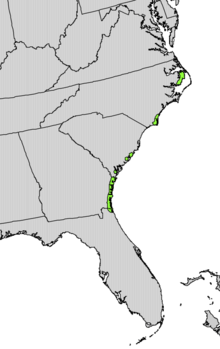Yucca gloriosa
| Yucca gloriosa | |
|---|---|
| | |
| Long-trunked Spanish Dagger | |
| Scientific classification | |
| Kingdom: | Plantae |
| Clade: | Angiosperms |
| Clade: | Monocots |
| Order: | Asparagales |
| Family: | Asparagaceae |
| Subfamily: | Agavoideae |
| Genus: | Yucca |
| Species: | Y. gloriosa |
| Binomial name | |
| Yucca gloriosa L. | |
 | |
| Natural range | |
| Synonyms[1] | |
|
Species synonymy
| |
Yucca gloriosa is a species of flowering plant in the family Asparagaceae, native to the beach scrub and sandy lowlands of the southeastern United States, from the Outer Banks of Virginia and North Carolina to Florida and Alabama. It is also widely cultivated as an ornamental and reportedly has become established in the wild in Italy, Turkey, Mauritius, Réunion, Guam, the Northern Mariana Islands, Puerto Rico, Argentina and Uruguay.[2]
Common names include:-
|
|
|
Description
Yucca gloriosa is an evergreen shrub. The plant is known to grow to heights above 5 m (16 feet).[4] It is caulescent, usually with several stems arising from the base, the base thickening in adult specimens. The long narrow leaves are straight and very stiff, growing to 30–50 cm (12–20 in) long and 2-3.5 cm wide. They are dark green with entire margins, smooth, rarely finely denticulate, acuminate, with a sharp brown terminal spine. Inflorescence is a panicle up to 2.5 m (8 ft) long, of bell-shaped white flowers, sometimes tinged purple or red. Fruit is a leathery, elongate berry up to 8 cm long.[5][6][7][8][9]
Habitat
Yucca gloriosa grows on sand dunes along the coast and barrier islands of the subtropical southeastern USA, often together with Yucca aloifolia and a variety formerly called Yucca recurvifolia or Y. gloriosa var. recurvifolia, now Y. gloriosa var. tristis.[10] In contrast to Y. gloriosa var. tristis, the leaves of Y. gloriosa var. gloriosa are hard stiff, erect and narrower. On the other hand, Y. aloifolia has leaves with denticulate margins and a sharp-pointed, terminal spine.
Distribution
Yucca gloriosa is native to the coast and barrier islands of southeastern North America, growing on sand dunes. It ranges from extreme southeastern Virginia south to northern Florida. It is associated with Yucca filamentosa, Yucca aloifolia, and Opuntia species.
Cultivation
The plant is widely cultivated in warm temperate and subtropical climates, and valued as an architectural focal point. In a domestic environment, the plant has average water requirements, and little maintenance is needed other than the removal of dead leaves when the shrub nears its ultimate height.[11] The plant is very hardy, without leaf damage at −20 °C (−4 °F), and can handle occasional snow and freezing temperatures.
Yucca gloriosa[12] and the cultivar 'Variegata'[13] have both gained the Royal Horticultural Society's Award of Garden Merit.
Properties
Yucca gloriosa has been known to cause skin irritation and even allergic reactions upon contact. The leaf points are even sharp enough to break the skin.[14]
Forms and varieties
In collections in Europe and overseas, there are many forms and hybrids (Sprenger, Förster) from the 18th and 19th centuries. The following names have been used for material of uncertain origin in the European garden flora.
|
|
References
- ↑ The Plant List
- ↑ Kew World Checklist of Selected Plant Families, Yucca gloriosa
- ↑ "BSBI List 2007". Botanical Society of Britain and Ireland. Archived from the original (xls) on 2015-02-25. Retrieved 2014-10-17.
- ↑ "bss.sfsu.edu". Retrieved 1 March 2007.
- ↑ RHS A-Z encyclopedia of garden plants. United Kingdom: Dorling Kindersley. 2008. p. 1136. ISBN 1405332964.
- ↑ Flora of North America v 26 p 429
- ↑ Linnaeus, Carl von. 1753. Species Plantarum 1: 319.
- ↑ Wunderlin, R. P. 1998. Guide to the Vascular Plants of Florida i–x, 1–806. University Press of Florida, Gainesville.
- ↑ Radford, A. E., H. E. Ahles & C. R. Bell. 1968. Manual of the Vascular Flora of the Carolinas i–lxi, 1–1183. University of North Carolina Press, Chapel Hill.
- ↑ World Checklist of Selected Plant Families, The Board of Trustees of the Royal Botanic Gardens, Kew, retrieved 2012-02-23, search for "Yucca recurvifolia"
- ↑ "cals.arizona.edu". Retrieved 1 March 2007.
- ↑ "RHS Plant Selector - Yucca gloriosa". Retrieved 7 July 2013.
- ↑ "RHS Plant Selector - Yucca gloriosa 'Variegata'". Retrieved 7 July 2013.
- ↑ "hgic.clemson.edu". Retrieved 1 March 2007.
External links
- http://yuccaagavaceae.com/ygloriosa.html
- http://yuccaagavaceae.com/photos/details.php?image_id=82 Original Erstbeschreibung
- USDA Plants Profile: Yucca gloriosa
- Yucca plant care
